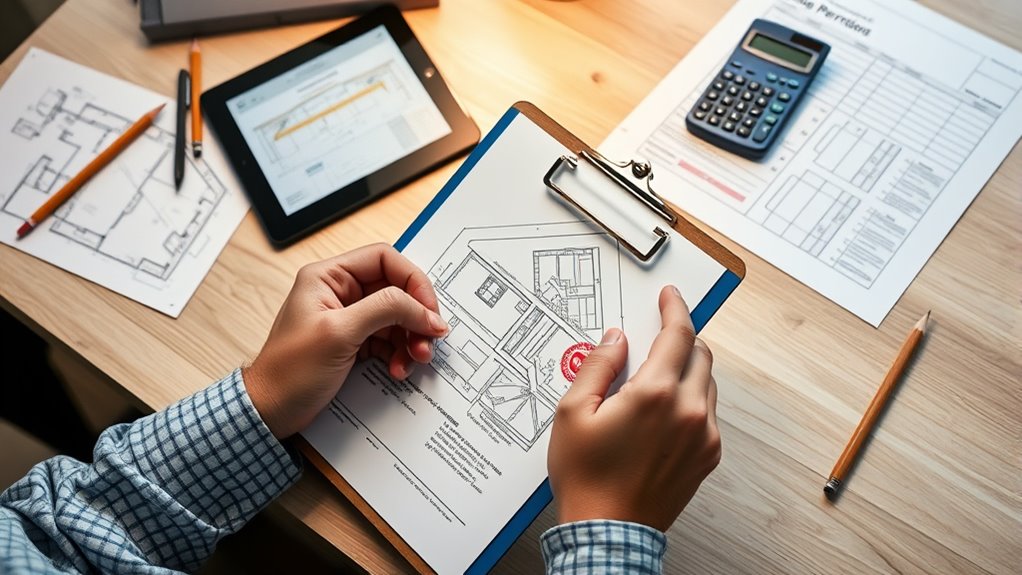Understanding permits for home improvements is vital to guarantee your projects comply with local codes, regulations, and safety standards. Typically, major changes like adding rooms, electrical wiring, or plumbing require permits, while small repairs may not. You’ll need to research local rules, submit applications, and possibly pay fees. Avoid delays or fines by following proper procedures. To learn more about how to navigate the permitting process confidently, continue exploring these essential guidelines.
Key Takeaways
- Building permits confirm that home improvement projects meet local safety, zoning, and environmental regulations.
- Major structural, electrical, or plumbing modifications typically require permits, while minor repairs may be exempt.
- The permitting process involves researching local codes, submitting detailed applications, and paying applicable fees.
- Ensuring compliance includes adhering to approved plans, scheduling inspections, and maintaining proper documentation.
- Consulting local authorities and resources helps clarify permit requirements, avoid delays, and ensure project approval.
What Are Building Permits and Why Are They Important
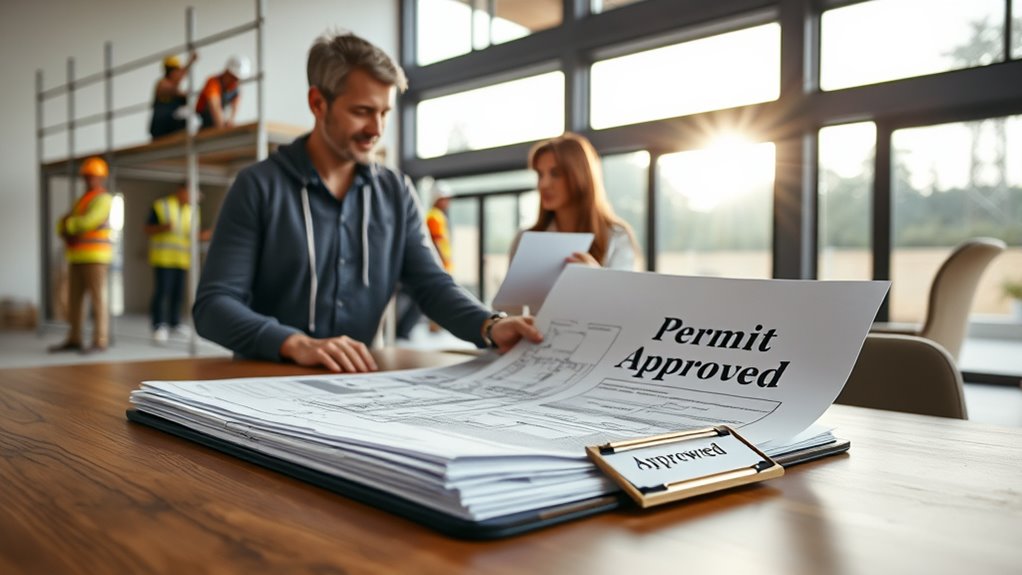
Have you ever wondered why building permits are required for home improvements? They are vital to ensure the permit process is followed correctly, protecting your property and safety. Building permits are official approvals from local authorities that confirm your project complies with building codes and regulations. This legal compliance helps prevent unsafe construction, structural issues, and future costly repairs. By obtaining a permit, you demonstrate that your project meets safety standards, zoning laws, and environmental requirements. Skipping this step might lead to fines, delays, or even having to undo work. Understanding what permits are and why they matter keeps your project on track and legally sound. It’s a fundamental part of responsible home improvement, giving you peace of mind and ensuring your project is built right. Additionally, proper permits demonstrate adherence to local regulations, which can be crucial if you decide to sell your home in the future.
Types of Home Improvement Projects That Usually Require Permits
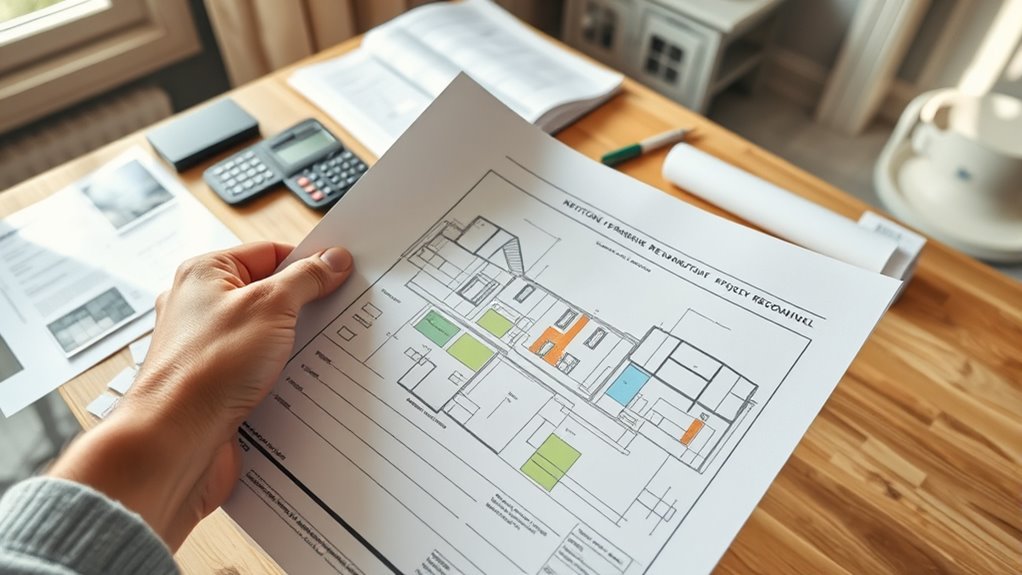
Many home improvement projects require permits to guarantee safety and code compliance. Structural additions, electrical work, and plumbing changes are common examples where permits are usually necessary. Knowing which projects need approval helps you avoid potential fines and delays. Additionally, remodeling a bedroom to incorporate rustic decor elements or updating fixtures may also require permits, especially if structural modifications are involved. Understanding building codes and regulations can further ensure your project remains compliant and smoothly completed. Familiarity with permitting procedures can streamline the approval process and prevent unexpected setbacks. Being aware of road sign regulations can also be helpful when planning outdoor or driveway modifications to ensure safety and legal adherence. Awareness of permitting requirements for organic gardening can be beneficial if you plan to expand your home garden or install new landscaping features.
Structural Additions Necessary Permits
Are you planning to add a new room or extend your current living space? Structural additions often require permits because they impact your home’s safety and stability. If you’re considering foundation reinforcement, you’ll need to secure the proper permits before starting work. This ensures the foundation meets local safety codes and prevents future issues. Similarly, a roof extension typically requires roof extension permits, as it affects your home’s structure and weatherproofing. Permits verify that your plans comply with building codes and zoning laws. Skipping these permits can lead to fines, delays, or even having to undo your project. Always check with your local authorities to determine which permits are necessary for your specific structural addition. Proper permits protect your investment and ensure a safe, compliant renovation. Additionally, understanding dog names can add a personal touch to your pet’s identity, making your home environment more welcoming. Being aware of building regulations can help you navigate the permit process more efficiently and avoid costly mistakes.
Electrical Work Regulations
When upgrading your home, electrical work is a common component that often requires permits to guarantee safety and code compliance. Permits ensure that your project meets electrical safety standards and wiring standards, reducing the risk of fires or electrical failures. Typical projects that usually need permits include adding new circuits, installing or upgrading electrical panels, and rewiring entire areas. Even minor changes, like replacing outlets or switches, can sometimes require approval depending on local regulations. By obtaining the necessary permits, you ensure your work adheres to safety protocols and legal requirements, preventing future complications or penalties. Properly licensed electrical work protects your home and family, helping you avoid hazards associated with unpermitted or substandard electrical modifications. Additionally, understanding permit requirements can help you plan your project more effectively and avoid delays, especially since proper permit management is crucial for regulatory compliance. Being aware of inspection procedures can also ensure your project passes inspections smoothly and remains compliant with local codes. Recognizing the importance of electrical safety standards helps prevent potential hazards and ensures your home remains secure.
Plumbing System Changes
If you’re planning to make significant changes to your plumbing system, securing the necessary permits is crucial. Plumbing system changes often involve adhering to plumbing codes and ensuring safe pipe installation. Permits are required for projects like installing new sinks, toilets, or water lines, as well as rerouting existing pipes. These projects typically involve:
- Ensuring compliance with local plumbing codes
- Proper pipe installation to prevent leaks and water damage
- Upgrading or replacing major plumbing components
- Financial considerations may also come into play if permits involve additional costs or inspections. Understanding building regulations can help prevent delays or issues with your project.
Obtaining permits guarantees your work meets safety standards and avoids future issues. Working without permits can lead to costly fines or needing to redo work. Always check with your local building department before starting any plumbing project that involves modifications to your system. Proper permits protect you and ensure your home’s plumbing is safe and reliable.
How to Determine When You Need a Permit for Your Project
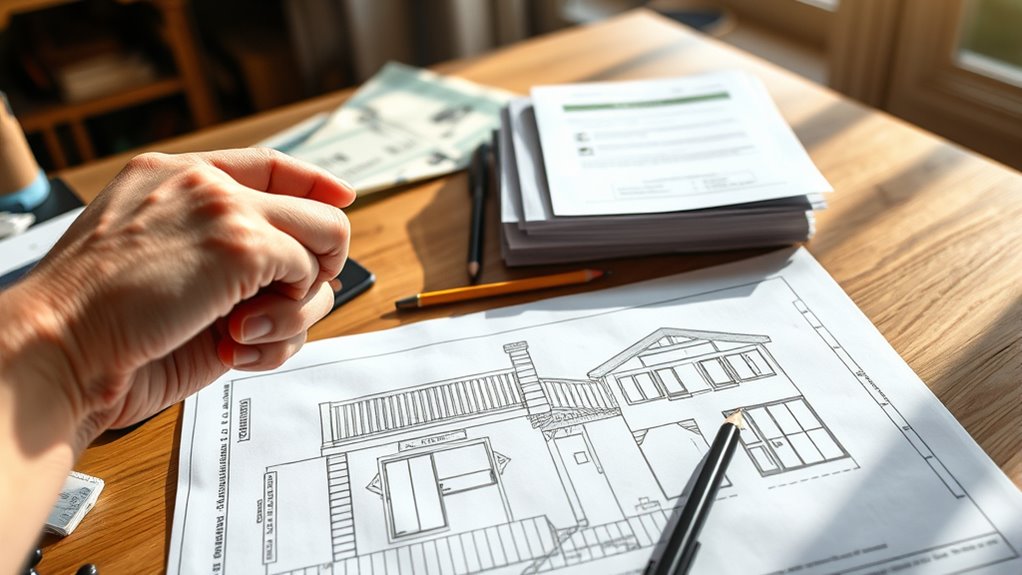
Determining whether you need a permit for your home improvement project starts with understanding local building codes and regulations. First, check if your project involves major structural changes, electrical work, or plumbing updates, which usually require permits. For smaller projects, DIY considerations come into play—some minor repairs or cosmetic upgrades might be exempt from permits, known as permit exemptions. However, even if your project seems simple, it’s essential to verify with your local building department to avoid fines or delays. Always review specific rules about permit exemptions to make sure you’re compliant. When in doubt, consulting with a professional or your local authority will help you decide whether a permit is necessary, saving you time and potential issues down the line. Additionally, understanding the importance of creative practice can help you approach your project with innovative solutions and adaptability. Being aware of electric power generation options, such as small bike generators, can also provide sustainable energy solutions for your home projects. It’s also beneficial to familiarize yourself with permit exemption criteria so you can confidently determine when a permit is or isn’t needed, ensuring adherence to local regulations and avoiding unnecessary complications. Moreover, familiarizing yourself with cultural and regional breakfast traditions can inspire you to incorporate local styles into your home’s aesthetic or planning process. Recognizing the role of sound design in creating engaging environments can inspire innovative ideas for your home improvements.
The Step-by-Step Process to Obtain Permits
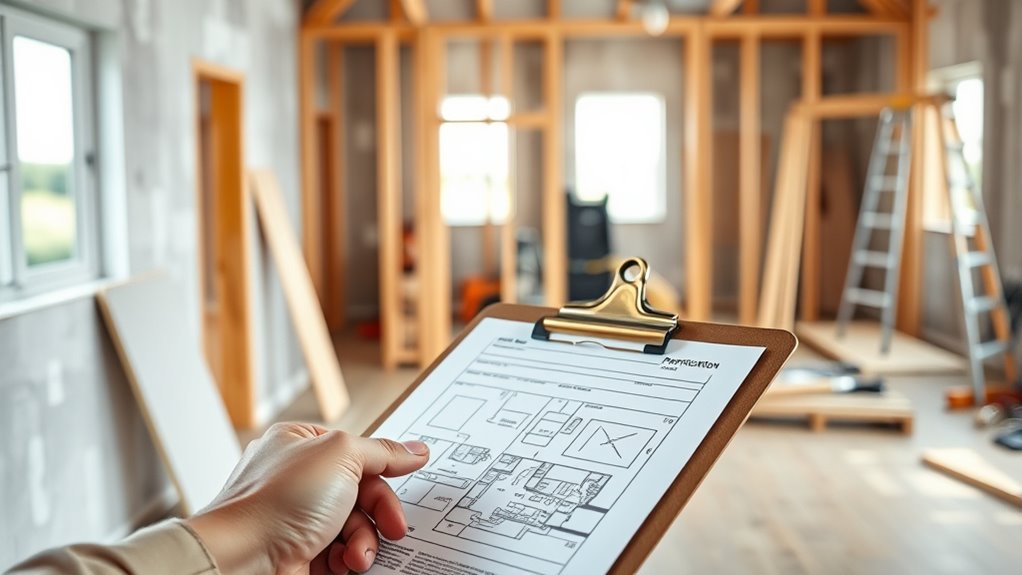
To get started, you need to research your local regulations to understand what’s required for your project. Once you have that information, you can fill out and submit the necessary application forms. Following this process carefully helps guarantee your home improvements stay compliant and on track. Additionally, reviewing guidelines for proper permit storage can prevent delays or issues during the approval process. Being aware of hydrotherapy benefits can also be useful if your project involves water features or modifications related to water safety, as well as understanding candy varieties and innovations that might inspire creative design elements. Considering self watering plant pots in your landscape design can also enhance the sustainability and maintenance of your outdoor space.
Research Local Regulations
Before you start gathering permits, acquiring a clear understanding of your local regulations is vital. Knowing your area’s zoning restrictions helps you avoid costly mistakes and guarantees your project complies with community standards. You should also familiarize yourself with homeowner responsibilities, which vary by municipality and can include inspections or specific documentation.
- Check zoning restrictions to determine what modifications are allowed
- Review local building codes and standards
- Understand your legal homeowner responsibilities for permits and inspections
Complete Application Process
Ready to get your permits, but unsure where to start? The complete application process involves filling out the necessary application forms accurately, providing detailed project plans, and paying permit fees. First, gather all required documents, such as blueprints or site plans. Complete the application forms carefully, ensuring all information is correct. Submit your forms along with any supporting documents to the local permitting office. Be prepared to pay permit fees, which vary depending on the scope of your project. After submission, your application will be reviewed by officials. They may request clarifications or additional documents. Once approved, you’ll receive your permit, allowing you to proceed confidently with your home improvement project. Staying organized and attentive to each step makes the process smoother.
Common Challenges and Mistakes During the Permitting Process
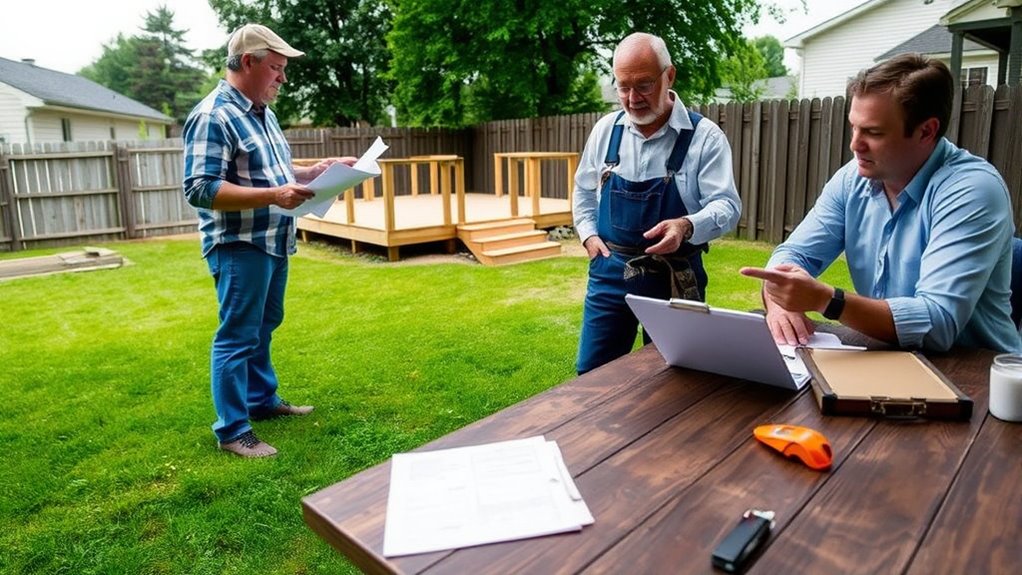
Managing the permitting process can be tricky, and many homeowners stumble into common pitfalls that delay their projects. Permit misconceptions often lead to unnecessary setbacks, so understanding these issues is vital. One common mistake is submitting incomplete or incorrect applications, which stalls approval. Another pitfall is underestimating the time needed for review, causing delays in starting work. Additionally, ignoring local building codes or misinterpreting requirements can result in costly rework or fines. To avoid these issues, double-check your application details, stay informed about local regulations, and communicate proactively with permitting officials. Being aware of these common pitfalls helps guarantee a smoother process, saving you time and money while keeping your project on track.
Tips for Ensuring Compliance and Passing Inspections
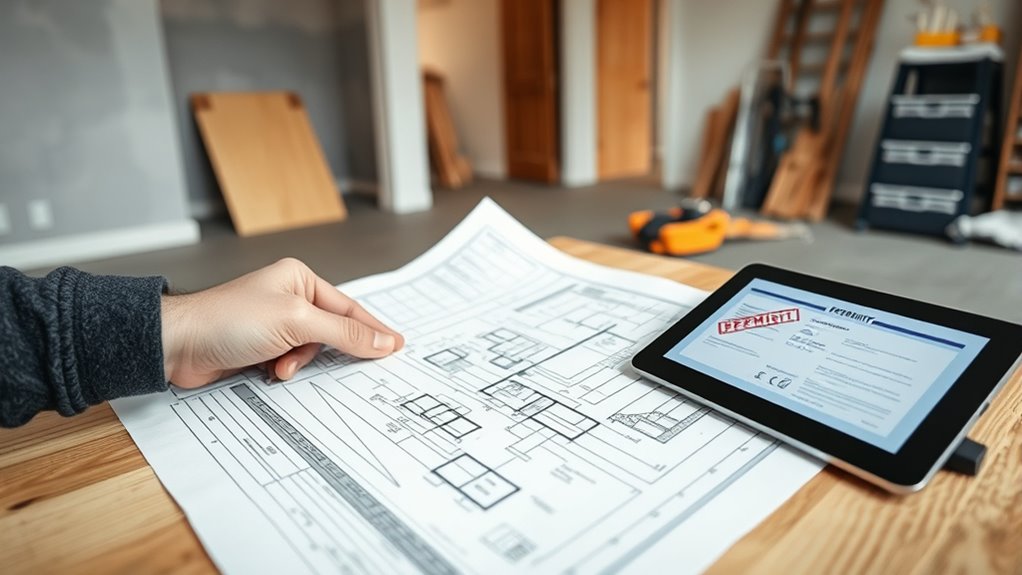
Ensuring compliance and passing inspections requires careful preparation and attention to detail throughout your home improvement project. First, stay aware of permit deadlines to avoid delays or penalties. Submit all required documentation on time and keep track of inspection schedules. Familiarize yourself with local codes and regulations to guarantee your work meets standards, preventing costly rework. Budget for permit fees upfront so they don’t cause surprises later. Before inspections, double-check that all work adheres to approved plans and safety requirements. Keep detailed records of inspections, approvals, and any modifications made. Communicate proactively with inspectors if issues arise, addressing them promptly. Staying organized and diligent helps ensure your project remains compliant, passes inspections smoothly, and avoids unnecessary setbacks or fines.
The Benefits of Proper Permitting for Your Home and Peace of Mind
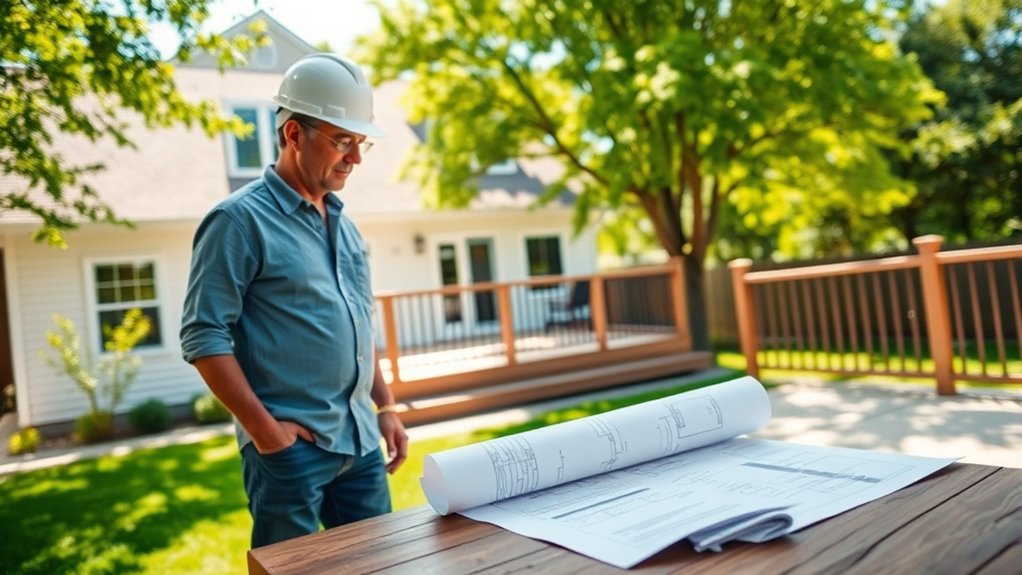
Proper permitting not only keeps your home improvement project compliant with local laws but also offers significant peace of mind. Many homeowners have permit misconceptions, believing they can skip permits or handle inspections themselves. By understanding your responsibilities, you ensure safety and avoid costly penalties. Proper permits help protect your investment and prevent future legal issues. When you secure the right permits, you demonstrate compliance and accountability, making selling your home smoother.
- Avoid permit misconceptions that could lead to violations or fines
- Fulfill homeowner responsibilities to ensure quality and safety
- Gain peace of mind knowing your project meets all legal standards
Frequently Asked Questions
Can I Start My Project Before Permits Are Approved?
You shouldn’t start your project before permits are approved, as permit delays can cause serious issues. Starting early might lead to fines, work stoppages, or needing to undo work if inspectors find violations. It can also disrupt your project timeline. To avoid problems, wait until your permits are issued. This ensures your project stays on track and complies with local regulations, saving you time and money in the long run.
Are Permits Necessary for Small or Cosmetic Repairs?
For small or cosmetic repairs, permits might not be necessary, especially if they fall under permit exemptions. You usually don’t need approval for simple tasks like painting, wallpapering, or replacing fixtures. However, it’s a good idea to check with your local building department, as rules vary. Even if permits aren’t required, confirm your work complies with safety codes to avoid issues later.
How Long Does the Permit Approval Process Usually Take?
Picture your project as a seed waiting to sprout; permit timelines can feel like the watering process—sometimes quick, sometimes slow. Typically, approval delays range from a few days to several weeks, depending on your local jurisdiction and project complexity. To avoid frustration, plan ahead and check with your city’s permit office. Being proactive helps make certain your permit gets approved smoothly, so your home improvement can grow without unnecessary delays.
What Are the Costs Associated With Obtaining Permits?
When you’re seeking permits, you should be aware of the costs involved. Permit fees vary depending on your project’s scope and local regulations, typically ranging from $50 to several hundred dollars. You might also face inspection costs, which guarantee your work meets safety standards. Budget for these expenses early, and check with your local building department to get accurate estimates, so you’re prepared financially for the permit process.
Can I Handle Permit Applications Myself or Should I Hire an Expert?
Think of permit applications as a complex puzzle—you can try to piece it together yourself or hire professionals to guarantee it’s done right. DIY permits might save you money but could lead to mistakes or delays. Hiring professionals brings expertise, streamlines the process, and reduces stress. Ultimately, if you’re confident in your knowledge, handling permits yourself is an option, but hiring professionals often offers peace of mind and guarantees compliance.
Conclusion
Think of your home as a masterpiece painting. Permits are the careful brushstrokes that guarantee your artwork is crafted safely and beautifully, avoiding smudges or cracks later. By understanding and following the permitting process, you’re adding vibrant, lasting colors to your home’s story. When you play by the rules, your renovation becomes a timeless masterpiece—confident, compliant, and filled with peace of mind. Embrace the process, and your home will shine brighter for years to come.

